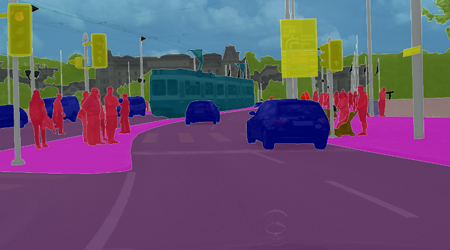How To Label Data For Semantic Segmentation Deep Learning Models?
 By Anolytics | 30 October, 2019 in Semantic Segmentation | 3 mins read
By Anolytics | 30 October, 2019 in Semantic Segmentation | 3 mins read

Labeling the data for computer vision is challenging, as there are multiple types of techniques used to train the algorithms that can learn from data sets and predict the results. Image annotation is the method annotate the images containing the object of interest to make the same recognizable to machines.
Although, there are different types of image annotation techniques, but semantic segmentation is one of them, provides a right picture to computer vision. It is purely a labor-intensive technique that requires pixel-level accuracy.
And this technique is not only crucial but also costly, hence, using the right tool is very important to maintain the accuracy. So, today we will learn right here how to label data for semantic segmentation using the right tool with human-powered skills.
Why Semantic Segmentation for Image Annotation?
Classifying the objects through computer vision, three process involved – first classification, second object detection and third or last image segmentation.
Image classification helps to recognize the objects and existing properties in an image, while object detection allows to move one-step further and find the accurate position of the object of interest, which is possible through bounding box annotation.
However, with image segmentation, you can recognize and understand what exactly is in the image at pixel level view. In semantic segmentation annotated images, each pixel in image belongs to a single class, as opposed to object detection where the bounding boxes of objects can overlap over each other.
The main purpose of using semantic image segmentation is build a computer-vision based application that requires high accuracy. AI-based models like face recognition, autonomous vehicles, retail applications and medical imaging analysis are the top use cases where image segmentation is used to get the accurate vision.
Also Read: How Semantic Segmentation & Landmark Annotation Improves Facial Recognition?
How to Label Images for Semantic Segmentation?
Though, there are many unreliable and inefficient labeling tools but choosing the right one is important, and annotators going to use this tool also should have enough skills and experience to annotate the semantic segmentation medical images.
To annotate images in semantic segmentation, outline the object carefully using the pen tool. Make sure touch the another end to cover the object entirely that will be shaded with a specific color to differentiate the object from nearby others.
Annotators can use the drawing pen tool, to outline the shapes in a speedy manner. This tool allows to draw freehand as well as straight lines, just like polygon tool and there is also option to erase the inaccurate outlines.
Objects and Nested Classifications for Instance Segmentation
For objects nested classification you can use instance segmentation. After drawing, use the list of objects or instances and create objects having separate regions. You can also edit and object using the pen tools to add or remove the regions.
Using this technique objects can be configured with nested classifications, which is also very handy for properties. And nested classifications are only created when you are configuring the editor on your computer using the annotation tool.
Bordering in Semantic Segmentation
While creating a semantic segmentation image, it is necessary to share borders between objects. Actually, when you will draw a new object, if you overlap the border of an already existing object, the new border you are drawing will be shared.
And this technique works very well when you are labeling objects from the background first. However, sometimes you want to first draw foreground and then draw an object behind without messing up the masks already created.
Brightness and Contrasting of Objects
In semantic segmentation, each object is shaded with specific color, but many times, objects in dark or nighttime images becomes hard to distinguish clearly from each other. So, here in this annotation method you can adjust the brightness and contrast level in the object that also brighten images and let out those images between objects.
Zooming/Panning and Exporting Images
You can also use zooming and panning features to do your job accurately. And while zooming the objects you can also use panning to check the objects in each image, whether, objects has been properly annotated or not.
Though, there is option to save the labeled images but when you done the semantic segmentation annotation on an image, you can export the label data that can be used as training data while training a machine learning model.
Also Read: Why Human Annotated Datasets is Important for Machine Learning?
Summing-up
Though, semantic segmentation annotation is more useful in assigning a class to every single pixel. And it very important for self-driving cars to provide the more precise information about the objects and traffic sings on the road through visualizing the multiple objects of the same class as a single entity.
However, it is now also used to train the areal view imagery based models used in agricultural and farming fields. Image segmentation deep learning can gather accurate information of such fields that helps to monitor the urbanization and deforestation through images taken from satellites or autonomous flying drones.
Anolytics is an emerging but reliable and affordable data annotation company, providing a complete image annotation solution for object detection in AI and machine learning with high-quality training data for differenttypes of model developments into different fields like healthcare, retail, agriculture, automotive and autonomous machines or robotics with best level of accuracy.
please contact our expert.
Talk to an Expert →